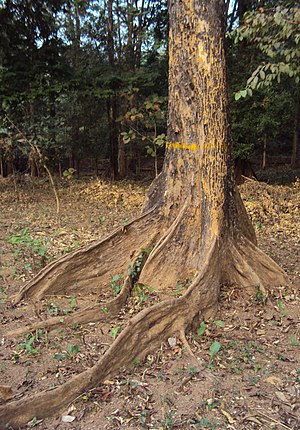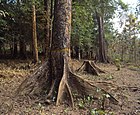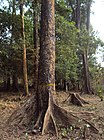Note: This is a project under development. The articles on this wiki are just being initiated and broadly incomplete. You can Help creating new pages.
Difference between revisions of "Pterocarpus dalbergioides"
(Created page with "{{stub}} ==Uses== {{Uses|}}, {{Uses|}}, {{Uses|}}, {{Uses|}}, {{Uses|}}, {{Uses|}}, {{Uses|}}, {{Uses|}}, {{Uses|}}, {{Uses|}}, {{Uses|}}.<ref name="Uses"/> ==Parts Used== {{...") |
|||
| (One intermediate revision by the same user not shown) | |||
| Line 1: | Line 1: | ||
| − | + | [[File:Andaman padauk 11.JPG|thumb|right|''Aloe Vera'']] | |
| + | '''Pterocarpus dalbergioides''' is a semideciduous or nearly evergreen tree with ascending branches, growing 25 - 40 metres tall. The bole is usually straight, cylindrical and buttressed, and can be up to 180cm in diameter. | ||
==Uses== | ==Uses== | ||
{{Uses|}}, {{Uses|}}, {{Uses|}}, {{Uses|}}, {{Uses|}}, {{Uses|}}, {{Uses|}}, {{Uses|}}, {{Uses|}}, {{Uses|}}, {{Uses|}}.<ref name="Uses"/> | {{Uses|}}, {{Uses|}}, {{Uses|}}, {{Uses|}}, {{Uses|}}, {{Uses|}}, {{Uses|}}, {{Uses|}}, {{Uses|}}, {{Uses|}}, {{Uses|}}.<ref name="Uses"/> | ||
==Parts Used== | ==Parts Used== | ||
| − | {{Parts Used|}}, {{Parts Used| | + | {{Parts Used|Bark}}, {{Parts Used|Flowers}}, {{Parts Used|Young leaves}}. |
==Chemical Composition== | ==Chemical Composition== | ||
| − | <ref name="chemical composition"/> | + | Phytochemical investigations of different morphological parts of plants of the genus Pterocarpus indicated that flavonoids, isoflavonoids, pterocarpans, aurones, lignans, |
| + | stilbenes, sterols, triterpenes and sesquiterpenes.<ref name="chemical composition"/> | ||
==Common names== | ==Common names== | ||
| Line 16: | Line 18: | ||
===Dravya=== | ===Dravya=== | ||
===Rasa=== | ===Rasa=== | ||
| − | |||
===Guna=== | ===Guna=== | ||
| Line 29: | Line 30: | ||
==Habit== | ==Habit== | ||
| − | {{Habit|}} | + | {{Habit|Semi-deciduous tree}} |
==Identification== | ==Identification== | ||
| Line 48: | Line 49: | ||
==Mode of Propagation== | ==Mode of Propagation== | ||
| − | {{Propagation|}} | + | {{Propagation|Seeds}} |
==How to plant/cultivate== | ==How to plant/cultivate== | ||
| − | <ref name="How to plant/cultivate"/> | + | A plant of the wet, lowland tropics, where it is found at elevations up to 100 metres. It grows best in areas where annual daytime temperatures are within the range 22 - 32°c, but can tolerate 15 - 37°c.<ref name="How to plant/cultivate"/> |
==Commonly seen growing in areas== | ==Commonly seen growing in areas== | ||
| − | {{Commonly seen|}}, {{Commonly seen|}}, {{Commonly seen| | + | {{Commonly seen|Found in deciduous forest}}, {{Commonly seen|Semi-moist deciduous forests}}, {{Commonly seen|Riverbanks}}. |
==Photo Gallery== | ==Photo Gallery== | ||
<gallery class="left" caption="" widths="140px" heights="140px"> | <gallery class="left" caption="" widths="140px" heights="140px"> | ||
| − | + | Andaman padauk 11.JPG | |
| + | Andaman padauk 12.JPG | ||
| + | Andaman padauk 13.JPG | ||
| + | Andaman padauk 14.JPG | ||
| + | Andaman padauk 15.JPG | ||
</gallery> | </gallery> | ||
| Line 64: | Line 69: | ||
<references> | <references> | ||
| − | <ref name="chemical composition">[ | + | <ref name="chemical composition">[http://impactfactor.org/PDF/IJPPR/11/IJPPR,Vol11,Issue4,Article5.pdf Chemical constituents]</ref> |
| − | <ref name="Leaf">[ | + | <ref name="Leaf">[Morphology]</ref> |
| − | <ref name="How to plant/cultivate">[ | + | <ref name="How to plant/cultivate">[http://tropical.theferns.info/viewtropical.php?id=Pterocarpus+dalbergioides Cultivation]</ref> |
<ref name="Uses">Indian Medicinal Plants by C.P.Khare</ref> | <ref name="Uses">Indian Medicinal Plants by C.P.Khare</ref> | ||
</references> | </references> | ||
==External Links== | ==External Links== | ||
| − | * [ ] | + | * [https://indiabiodiversity.org/species/show/259437 Pterocarpus dalbergioides on indiabiodiversity.org] |
| − | * [ ] | + | * [https://www.flowersofindia.net/catalog/slides/Andaman%20Redwood.html Pterocarpus dalbergioides on flowersofindia.net] |
| − | * [ ] | + | * [https://pfaf.org/user/Plant.aspx?LatinName=Pterocarpus+dalbergioides Pterocarpus dalbergioides on pfaf.org] |
[[Category:Herbs]] | [[Category:Herbs]] | ||
| + | [[Category:Pages without herbs images]] | ||
Latest revision as of 11:17, 21 July 2020
Pterocarpus dalbergioides is a semideciduous or nearly evergreen tree with ascending branches, growing 25 - 40 metres tall. The bole is usually straight, cylindrical and buttressed, and can be up to 180cm in diameter.
Contents
- 1 Uses
- 2 Parts Used
- 3 Chemical Composition
- 4 Common names
- 5 Properties
- 6 Habit
- 7 Identification
- 8 List of Ayurvedic medicine in which the herb is used
- 9 Where to get the saplings
- 10 Mode of Propagation
- 11 How to plant/cultivate
- 12 Commonly seen growing in areas
- 13 Photo Gallery
- 14 References
- 15 External Links
Uses
[[:Category:Ayurvedic Herbs known to be helpful to treat |]], [[:Category:Ayurvedic Herbs known to be helpful to treat |]], [[:Category:Ayurvedic Herbs known to be helpful to treat |]], [[:Category:Ayurvedic Herbs known to be helpful to treat |]], [[:Category:Ayurvedic Herbs known to be helpful to treat |]], [[:Category:Ayurvedic Herbs known to be helpful to treat |]], [[:Category:Ayurvedic Herbs known to be helpful to treat |]], [[:Category:Ayurvedic Herbs known to be helpful to treat |]], [[:Category:Ayurvedic Herbs known to be helpful to treat |]], [[:Category:Ayurvedic Herbs known to be helpful to treat |]], [[:Category:Ayurvedic Herbs known to be helpful to treat |]].[1]
Parts Used
Chemical Composition
Phytochemical investigations of different morphological parts of plants of the genus Pterocarpus indicated that flavonoids, isoflavonoids, pterocarpans, aurones, lignans, stilbenes, sterols, triterpenes and sesquiterpenes.[2]
Common names
| Language | Common name |
|---|---|
| Kannada | |
| Hindi | |
| Malayalam | |
| Tamil | |
| Telugu | |
| Marathi | |
| Gujarathi | |
| Punjabi | |
| Kashmiri | |
| Sanskrit | |
| English |
Properties
Reference: Dravya - Substance, Rasa - Taste, Guna - Qualities, Veerya - Potency, Vipaka - Post-digesion effect, Karma - Pharmacological activity, Prabhava - Therepeutics.
Dravya
Rasa
Guna
Veerya
Vipaka
Karma
Prabhava
Habit
Identification
Leaf
| Kind | Shape | Feature |
|---|---|---|
Flower
| Type | Size | Color and composition | Stamen | More information |
|---|---|---|---|---|
| {{{5}}} |
Fruit
| Type | Size | Mass | Appearance | Seeds | More information |
|---|---|---|---|---|---|
Other features
List of Ayurvedic medicine in which the herb is used
Where to get the saplings
Mode of Propagation
How to plant/cultivate
A plant of the wet, lowland tropics, where it is found at elevations up to 100 metres. It grows best in areas where annual daytime temperatures are within the range 22 - 32°c, but can tolerate 15 - 37°c.[4]
Commonly seen growing in areas
Found in deciduous forest, Semi-moist deciduous forests, Riverbanks.
Photo Gallery
References
- ↑ Indian Medicinal Plants by C.P.Khare
- ↑ Chemical constituents
- ↑ [Morphology]
- ↑ Cultivation
External Links
- Ayurvedic Herbs known to be helpful to treat
- Herbs with Bark used in medicine
- Herbs with Flowers used in medicine
- Herbs with Young leaves used in medicine
- Habit - Semi-deciduous tree
- Index of Plants which can be propagated by Seeds
- Herbs that are commonly seen in the region of Found in deciduous forest
- Herbs that are commonly seen in the region of Semi-moist deciduous forests
- Herbs that are commonly seen in the region of Riverbanks
- Herbs
- Pages without herbs images





